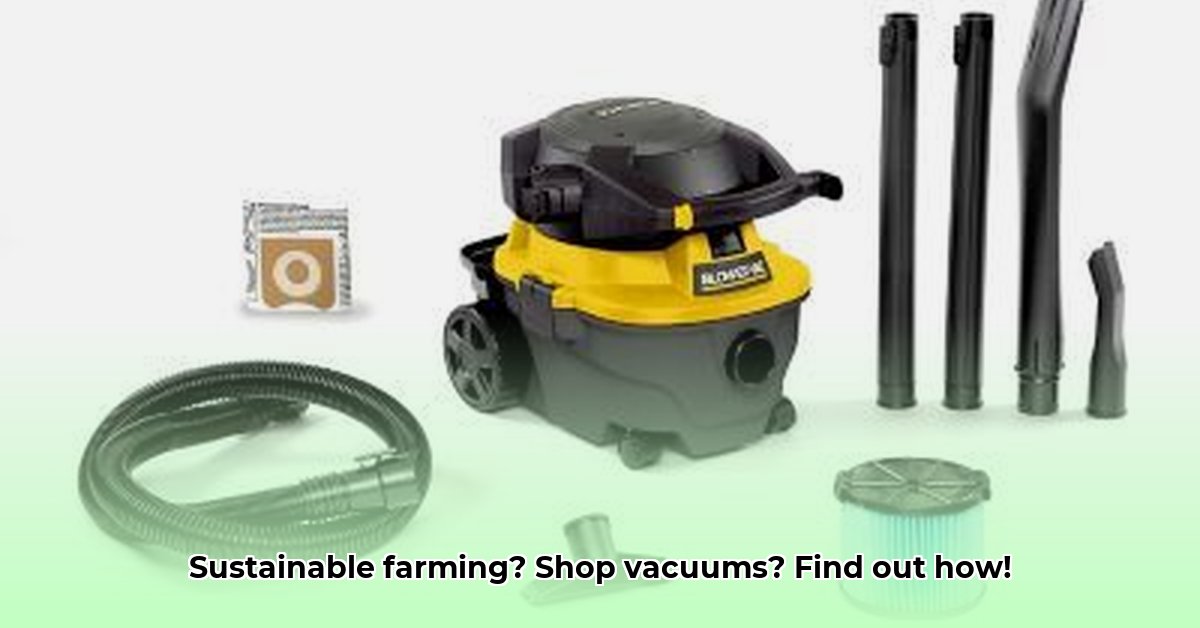
Shop Vacuum Tractor Supply: Enhancing Farm Sustainability Through Cleanliness
Maintaining a clean and organized farm is surprisingly crucial for sustainable agricultural practices. While it might seem like a minor detail, cleanliness directly impacts efficiency, resource management, and environmental responsibility. A high-quality shop vacuum, readily available at Tractor Supply, becomes an unexpectedly valuable tool in this pursuit. How can a simple shop vacuum contribute to a greener, more sustainable farm? Let's explore. For more commercial options, check out Tractor Supply Commercial.
Why Farm Cleanliness is Key to Sustainability
A tidy farm equates to a healthy farm. Spilled grain attracts pests, manure piles breed diseases, and scattered debris hampers efficient operations. "A clean farm is a healthy farm," affirms Dr. Emily Carter, Agricultural Extension Specialist at Purdue University. This isn't just about aesthetics; managing waste and controlling pests is pivotal to environmental sustainability, protecting crops, livestock, and the surrounding ecosystems. A powerful shop vacuum is a surprisingly effective tool in this endeavor. Did you know that effective waste management can reduce greenhouse gas emissions by up to 15%?
Selecting the Right Shop Vacuum for Your Farm
Choosing the ideal shop vacuum depends entirely on your farm's size and specific needs. A large-scale operation necessitates a more powerful model than a smaller family farm. Key factors to consider when making your selection include:
- Horsepower: Higher horsepower translates to more potent suction, enabling faster cleanup of tougher messes. Smaller farms may suffice with lower horsepower models, while larger operations need higher horsepower units.
- Dustbin Capacity: Assess your regular cleanup volume. Larger dustbins reduce interruptions for emptying, saving both time and effort.
- Filtration: Filter type is critical, particularly when dealing with fine dust or allergens. HEPA filters excel at capturing minute particles but are generally pricier. Standard filters are adequate for less demanding tasks.
- Portability: Consider the ease of moving the vacuum around your property; a lightweight model is more manageable but may lack the power of heavier units.
- Wet/Dry Functionality: Many shop vacuums handle both wet and dry messes. This versatility is advantageous on farms where unexpected spills are common.
A comparison of various models is presented below:
| Feature | Model A (Heavy-Duty) | Model B (Mid-Range) | Model C (Lightweight) |
|---|---|---|---|
| Horsepower | 6 HP | 5 HP | 3 HP |
| Dustbin Capacity | 15 gallons | 10 gallons | 5 gallons |
| Filtration | HEPA | Standard | Standard |
| Portability | Low | Moderate | High |
| Wet/Dry | Yes | Yes | No |
Remember, these are examples; always check specifications of models at your Tractor Supply store. Consult staff for expert advice.
Practical Applications of a Shop Vacuum on Your Farm
A shop vacuum's uses extend far beyond workshop cleanup. Its applications directly support sustainable farming:
Cleaning Barns and Stables (Disease Prevention): Regularly cleaning animal stalls prevents disease outbreaks, improving animal health and reducing antibiotic use.
Grain Storage Facilities (Waste Reduction): Removing spilled grain and chaff minimizes waste and prevents spoilage, reducing the need for pesticides to control pests.
Maintaining Machinery (Extended Lifespan): Keeping equipment clean extends its lifespan, reducing replacements and waste from discarded parts.
Workshop Cleanup (Efficiency): A clean workspace improves efficiency and reduces workplace accidents.
Managing Spills (Environmental Protection): Quick spill cleanup minimizes environmental contamination, especially with hazardous materials.
Implementing Precision Irrigation for Sustainable Farming
Core Insights:
- Precision irrigation maximizes crop yields while conserving water.
- System selection depends on factors such as soil type, crop needs, and climate.
- Smart irrigation systems offer data-driven efficiency but require initial investment.
The Importance of Sustainable Irrigation Practices
Water scarcity is a significant agricultural challenge. Traditional methods often waste water. Precision irrigation, by contrast, focuses on water efficiency. It's about delivering the right amount of water to each plant, precisely when it's needed. This targeted approach minimizes waste and optimizes plant growth. "Precision irrigation is crucial for adapting to climate change and ensuring food security," states Dr. David Rodriguez, Professor of Agricultural Engineering at the University of California, Davis.
Choosing the Right Irrigation System for Your Needs
Various efficient water distribution methods exist. Drip irrigation delivers water directly to plant roots, minimizing evaporation. Sprinkler systems suit larger areas but may be less precise. Flood irrigation, while simple, is often least efficient. The optimal choice depends on your farm's unique conditions, including terrain, crop type, and resources.
Implementing Precision Irrigation: A Step-by-Step Guide
- Soil Analysis: Determine your soil's water-holding capacity to guide your irrigation strategy.
- System Selection: Choose an appropriate system (drip, sprinkler, etc.) based on your crops and terrain.
- Installation: Proper installation prevents leaks and ensures even water distribution. Professional installation is beneficial.
- Sensor Integration: Smart systems use sensors to monitor soil moisture and adjust watering accordingly for optimized plant health.
- Data Management: Regularly monitor and analyze sensor data to optimize system performance.
- Maintenance: Regular maintenance (cleaning, leak repair) is crucial for system longevity.
Smart Irrigation: Balancing Costs with Long-Term Benefits
Smart irrigation systems offer substantial advantages but require initial investment. Long-term cost-effectiveness depends on water prices, crop value, and system lifespan. Carefully consider the return on investment (ROI).
Mitigating Potential Risks in Precision Irrigation
| Technology | Risk of Failure | Impact of Failure | Mitigation Strategies |
|---|---|---|---|
| Smart Irrigation Sensors | Moderate | Reduced yield | Redundant sensors; regular calibration; preventative maintenance; robust data backup |
| Automated Controllers | Low | Inconsistent watering | Redundant power supply; regular software updates; system diagnostics and alerts |
Collaboration for Successful Implementation
Successful implementation requires collaboration amongst farmers, researchers, government agencies, and technology providers. Sharing best practices is key to widespread adoption. This includes educational programs and financial incentives. "Collaboration is the cornerstone of sustainable agriculture," notes Mr. John Miller, Director of Sustainable Farming Initiatives at the USDA.